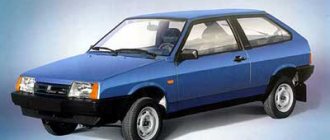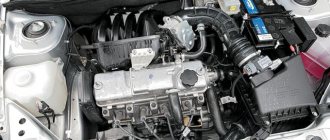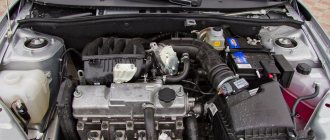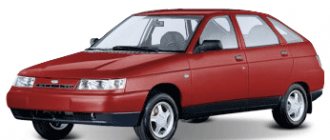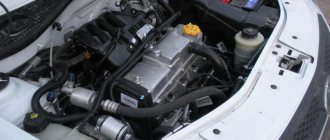Engine 11183 is the engine installed on the cheapest versions of budget VAZ cars: the Lada Kalina sedan (2001 - 2011) and the Lada Granta model that replaced it (2011). They replaced the Samara family of cars that had been produced for a long time.
The VAZ 11183 engine is a product of modernization of the well-known 2111 engine, which in turn replaced the outdated (carburetor) 21083.
Engine 11183 (another name for VAZ 21114 engine) differs from 2111 (cylinder capacity 1.5 liters):
- height of the cylinder block;
- increased piston stroke.
Due to this, the designers managed to increase the volume of the cylinders and increase the engine power. As a result of the work carried out, engine 11183 significantly improved its performance characteristics (reliability, environmental friendliness, etc.). Due to the fact that its assembly is carried out at various production sites of AvtoVAZ OJSC, the engine is known to car enthusiasts under the names:
- 11183;
- engine 21114;
- 2114;
- Kalina motor;
- motor Kalina, etc.
Specifications
Download .xls file
xls
Download picture
Send by email
| PARAMETER | MEANING |
| Cylinder displacement, cubic meters cm | 1.596 |
| Rated power, l. With. (at 5200 rpm) | 82 |
| Maximum torque, Nm (at 2700 rpm) | 120 |
| Number of cylinders | 4 |
| Number of valves per cylinder, pcs. | 2 |
| Total number of valves, pcs. | 8 |
| Cylinder diameter, mm | 82 |
| Piston stroke, mm | 75.6 |
| Spark plug | A17 DVRM, BPR6ES (NGK), etc. |
| Cylinder operation diagram | 1 — 3- 4- 2 |
| Supply system | Injector (electronically controlled distributed injection) |
| Fuel | Unleaded gasoline AI-92 |
| Fuel consumption, l./100 km. (city/highway) | 8,8/5,7 |
| Lubrication system | Combined (spraying + under pressure) |
| Engine oil type | 5W-30, 5W-40, 10w-30 and 10W-40 |
| Engine oil quantity, l | 3.5 |
| Cooling system | Liquid, closed type |
| Coolant | Based on ethylene glycol |
| Motor resource, thousand hours. (theory/practice) | 150/300 |
| Weight, kg | 127 |
The engine is installed on cars produced by VAZ: Lada Samara 2 family; Sedan Lada Kalina (2004 - 2013); Lada Granta 1.6 l., 8-cl., manual transmission (2011-present).
Interior review of Kalina station wagon
The interior of the Lada Kalina station wagon does not spoil the positive impression that the appearance creates. You can immediately pay attention to the fact that getting inside the car is now extremely comfortable thanks to the expanded door openings. The driver will immediately appreciate the improved ergonomics, which mainly affect the control of various vehicle functions. Now you can control the operation of any part of the car without any problems, because the control buttons are at hand.
I am glad that now the control unit for the electrical package on the driver's door fully complies with all European standards, which makes it possible to raise, lower or heat the windows without any difficulties. The instrument panel has excellent visibility of all indications, and the soft greenish backlight improves readability and is not at all irritating to the eye.
The salon has become more comfortable and richer
The panels of the Kalina Universal 2013 car are made of high-quality plastic that does not creak or knock when driving. Thanks to the special coating, there are no fingerprints left on the plastic, and cleaning will not cause any difficulties. A few words about the seats: the seats are made of fabric materials standard for domestic cars, without much sophistication. But it is worth saying that it is comfortable to be in them, the body is well fixed inside the seat. The tilt of each chair is adjustable. The disadvantage is that the driver's seat cannot be adjusted in height. Although the visibility that opens in front of the driver thanks to the large windows is already quite good.
The technological equipment of the Lada Kalina station wagon is quite good. There is an air conditioner in the cabin, the control button for which is located on the dashboard, which makes it easy to set the desired temperature. In addition, the Luxury package includes a navigator, which will help you not only create the optimal route, but also determine the speed and fuel consumption.
Of course, the car cannot be called particularly high-tech, but it fully meets all modern requirements.
Description
Like all previous models, the VAZ 11183 engine is a classic four-stroke, in-line, 4-cylinder power unit with an overhead camshaft.
The increase in cylinder volume was achieved through the use of a higher cylinder block than that of the prototype. Its height is 2.3 mm higher than the height of the 2111 engine block and is 197.1 mm (from the crankshaft axis to the top surface). The diameter of the cylinders did not change, but the dimensions and shape of the combustion chamber had to be changed.
The cylinder head is made of aluminum alloy. A camshaft is installed in its upper part, and special ducts are cast in the lower part, designed to supply coolant to the combustion chambers. The same channels are also available in the cylinder block housing.
The crankshaft and camshaft of the engine are cast from cast iron, the pistons are made from aluminum alloy. Forged connecting rods (steel).
Design Features
After modernizing the 21114 engine taken as a standard, the 11183 engine has the following design nuances:
- “high” cylinder block – height increased by 2.3 mm compared to 2110;
- fasteners - the holes are threaded with M12 standard pitch;
- crankshaft – original, steel, forged, crank radius increased by 2.3 mm;
- cylinder head gasket – thickness 1.2 mm, regular;
- combustion chamber – increased to 26 cm 3 due to two-stage milling;
- catcollector - short tubes, round block shape.
To reduce manufacturing costs, a connecting rod-piston group, a pulley and a crankshaft flywheel from the 2110 engine are installed in the engine. The volumes of the combustion chambers are increased for the engine with the sole purpose of ensuring a compression ratio of 9.6 - 10.0.
The manufacturer does not provide hydraulic compensators in this internal combustion engine, therefore, on the one hand, the use of lower quality oil is allowed. On the other hand, the savings in the operating budget when using cheap lubricants are “eaten up” by the costs of periodically adjusting the valves in a service station, since the manufacturer recommends doing it more often.
The main attachments are driven by their own belts. The design of tensioners (for example, a generator) leaves much to be desired. But the internal combustion engine allows you to increase power in the following ways. Moreover, a reasonable boost does not require major repairs to be carried out more often than the established deadline.
Even without improving the performance, the engine is high-torque and torquey, and produces 200% of the service life declared by the manufacturer. The available repair dimensions of the piston group make it possible to increase the service life, taking into account several overhauls, up to a million kilometers.
Maintenance
The gas distribution mechanism is driven by a belt, which requires replacement every 45 thousand km. mileage In addition, valve clearances also require periodic adjustment.
A significant advantage of the VAZ 11183 engine is that if the drive belt breaks, hard contact of the valve with the piston surface is eliminated (the valves do not bend).
Maintenance that ensures long-term operation of the power unit comes down to:
- regularly inspect the engine to detect oil and coolant leaks. If any defects are identified, they must be eliminated;
- timely replacement of engine oil - every 15,000 km.
Advantages
The VAZ 11183 engine with 8 valve injector has a fairly large number of positive qualities with which many associate its popularity. Owners of cars with this engine note the following advantages:
- The safety margin of the main elements is reserved by the factory. This leads to the fact that the engine, with the right approach, lends itself well to tuning. At the same time, increasing power to 130-150 horsepower does not affect its service life in any way.
- Many people say that the motor has received a much longer resource in comparison with its brothers. This is a completely justified statement, since it began to be assembled with improved quality components, so with the right approach it can go much further.
- The motor is very unpretentious in operation. Many people pay special attention to the lubrication system, since the quality of the oil is practically unimportant, since there are no hydraulic compensators in the design. Of course, you should follow the manufacturer's recommendations.
- Unpretentiousness to fuel. The compression ratio was increased, but to reasonable limits, and the power system was designed in such a way that the engine copes well with low octane gasoline. This is an excellent solution, given the quality of domestic gasoline.
- Timing belt The main advantage of using an 8-valve mechanism is that if the belt breaks, there is no contact between the pistons and the valves. Therefore, you should not be afraid that unplanned repairs may be required.
Malfunctions
Motor 11183 is characterized by malfunctions that are typical for all power units produced by AvtoVAZ OJSC.
| FAULTS | CAUSES | REMEDY METHODS |
| The engine does not warm up to the required temperature. | Thermostat is faulty. | Replace thermostat. |
| Knocking and noise in the engine. | 1. Valve clearances are not adjusted. 2. Wear of the crankshaft main bearings. 3. Wear of connecting rod bearings. 4. Pistons knock | Adjust valve clearances. Malfunctions associated with wear of bearings and the need to replace pistons are recommended to be repaired in a specialized car service center. |
| The engine operates unstably (“speeds float”, “troits”, etc.) | 1. The throttle position sensor is faulty. 2. The valve has burned out. 3. The gasket is broken. 4. The ignition module is faulty. | ŸReplace the faulty sensor. Measure compression in cylinders. If it is below normal, then the malfunction is hidden in the gas distribution mechanism. If compression is normal, the fault must be looked for in the ignition module. |
Tuning
Engine tuning is most often carried out in order to increase the power above that indicated in the passport. On a VAZ 11183 engine, it can be increased without special costs through a number of sequential operations:
- Increase engine power to 90 hp. With. It is possible if you replace the existing camshaft with “OKB Dinamika 108” or “Nuzhdin 10.93” and install a split gear. With the correct phase settings, the power unit can develop power up to 90 hp. With.
- By installing a receiver, an enlarged 54 mm throttle body and a Spider 4-2-1 exhaust, you can increase the engine power to 100 hp. With.
- After modification of the cylinder head and intake manifold, the engine power will increase to 115 hp. With. True, for this it is necessary to replace the standard valves with lighter ones (T-shaped).
- By replacing the piston group with a lighter one (for example, from a LADA Priora car), we get a power of more than 120 hp. With.
The same result can be obtained if you install on the engine:
- compressor PK-23-1;
- camshaft “Nuzhdin 10.42” or “Nuzhdin 10.63”.
The power of the 8-valve power unit can be further increased, but this will lead to a significant reduction in its service life.
The history of the appearance of the Lada Kalina VAZ 1118 car
The creation of this model began back in 1993 at the Volzhsky Automobile Plant. At the final stage of development in 1998, the car was named Lada Kalina; VAZ 1118 is the in-plant serial designation for the sedan model. The car was first presented to the public in 2000, and at the end of 2004 it went on sale.
The car received rave reviews from the public, which immediately turned it into a people's car. Thanks to this success, in mid-2007 the Volzhsky Automobile Plant launched production of the Lada Kalina VAZ 1118 with an updated 16-valve engine, the volume of which was 1.4 liters. After 2 months, the sedan was equipped with brakes with an anti-lock system. VAZ 21118 Kalina became the first domestic car with such technology.
Within two years, AvtoVAZ produced more than 80 thousand copies of the car. Sales of the popular model exceeded all expectations of the Russian automobile industry, so in 2007 the production of the Lada Kalina VAZ 1118 was increased, which made it possible to produce 145 thousand cars per year.
The sedan model was tested by the President of the Russian Federation V.V. Putin, who accelerated to 120 km/h on the test track. By 2009, this model was included in the ranking of the most popular vehicles in the country; it occupied fourth place on this list. In the same year, almost 61 thousand copies of this model were sold.
Over the years of production, the car has been constantly improved. Starting from 2010, the Lada Kalina VAZ 1118 was equipped with a factory sound system and updated black plastic inside the cabin.
At the beginning of 2011, it was officially announced that production of the first generation Kalina would cease. This was due to the fact that AvtoVAZ began preparing a new model, which was developed on the previous generation platform. Immediately after this announcement, sales of the Lada Kalina VAZ 1118 reached unprecedented heights, which allowed it to climb to 1st place in the number of cars sold in the country (almost 60 thousand copies). At the beginning of 2013, the first generation of the car disappeared from dealer showrooms as it was replaced by the second generation.
